8 Ways To Write Product Descriptions That Sell (With Examples)

Table of Contents
- Introduction
- What is a good product description?
- Why is a product description so important?
- What are the elements of a product description?
- How do you write a good product description?
- Key takeaways
- Conclusion
- FAQs
In the time and age of online marketing, having an active online appearance is essential for businesses. While a flawless website, high-quality images, and a good social media outreach are the precursors of success, well-written and crisp product descriptions are the backbone of a positive customer experience.
According to one research, the most desired information that consumers seek about products that they see online are product descriptions. Thus, to excel as a business in today’s digital landscape, it is important to know how to write product descriptions that sell.

What is a Good Product Description?

The building block of selling one’s products and services is knowing how to write product descriptions that sell. Product descriptions serve more than just the purpose of describing a product or a service. They exhibit the value and uniqueness of a product or service and how it solves a potential customer’s problem to the people visiting the company website.
- A good product description boosts sales and engagement on the company website. In a way, if written well, a product description can act as a sales pitch to the customer. When they feel well-informed and find the product relevant, they are sure to buy it.
- Since a compelling description brings in more engagement, it will automatically lead to a company’s website and online shop ranking higher as well.
- Good product description writing reflects the brand and its target audience’s needs. It effectively bridges the gap between the brand and its customers.
Why is a Product Description so Important?
Did you know that around 98% of customers (OneSpace) are dissuaded from buying a product due to incorrect or incomplete product content? Thus, it is crucial for a brand to ace product description writing.
Product images and product descriptions are the two things that influence customers’ buying decisions when they visit a website or an e-store. Product descriptions boost conversions, impact sales, strengthen a brand’s identity, build trust between the customers and the brand, and largely impact a website’s SEO, thereby its ranking on search results pages.
Another reason to figure out how to write product descriptions that sell is that they enhance a website’s professional look. Standing out amongst one’s competitors in the industry is one of your goals as a business. Through your product descriptions, you can tell your customers what plus points your company’s products have over the other competitive products in the market.
What are the Elements of a Product Description?

Product descriptions that sell are made up of several crucial elements. Here are some basic elements of a product description:
- Product name
- Keyword enrichment
- Specifics or key features of the product (like color, weight, durability, dimensions, availability, etc.)
- Benefits
- A headline
- Brand voice
The key elements of a product description can also be summed up as nature, purpose, appearance, and function. It should also include any other details that might satisfy all possible customer queries.
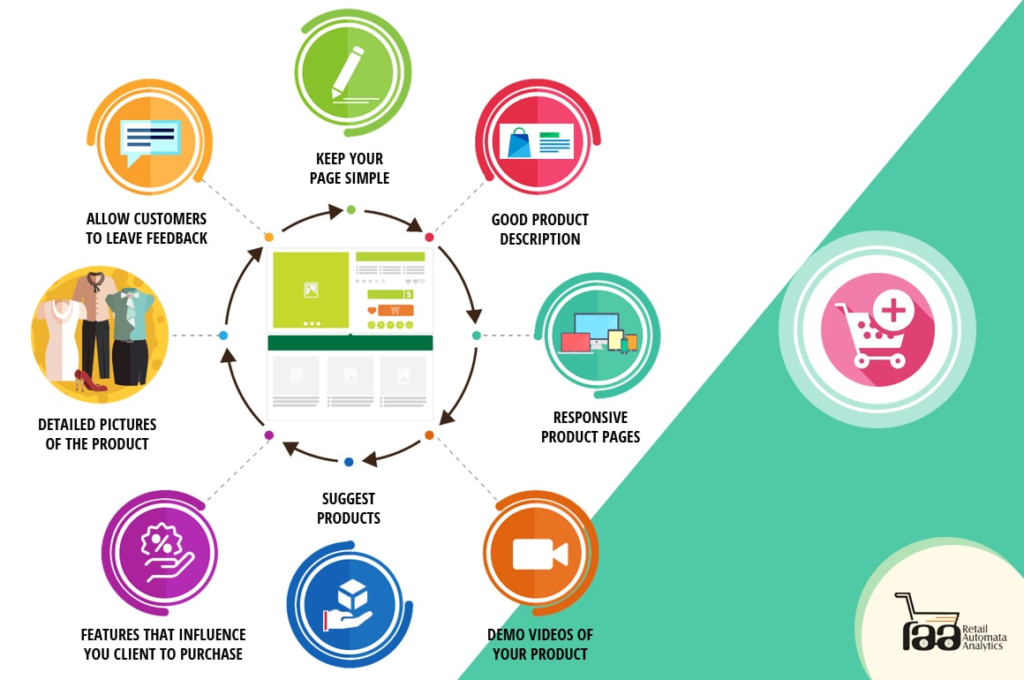
How do You Write a Good Product Description?
A product description that sells is not simply a line-by-line narration of the product and how it looks. It is important that the description reflects the brand’s voice and engages the customers while they are making a buying decision. Let’s look at some ways in which one can write product descriptions that sell, with examples included:
1. Answer important questions before writing
Asking yourself a few questions is a great idea to begin with while crafting a description copy. For example:
- Who is the target audience?
- Which language or tone best addresses the audience?
- What problem could this product offer a solution for?
- What is its exact use?
- What can the customer expect from the product?
- Is there any additional benefit?
Keep in mind that both product questions and customer questions need to be addressed in the description. Once you know what questions need to be addressed, writing a product description that sells will then become the easier part of the task.
2. Know your audience
Another great way to start writing a product description is by creating a buyer persona for a specific product. With the profile of an ideal customer in mind, a brand can easily craft a brilliant product description. A well-researched customer profile will help the brand understand the customer’s needs and expectations. Focus on the core audience and craft a sales pitch. Keep in mind that ‘the audience is indeed the king’.
3. Focus on benefits and features
The prime focus of a well-crafted product description is undoubtedly the benefits and key features of the product. The features are what’s evident when writing a description. But it is the benefits’ bit that requires more work. Use imagination and creative writing to list the product’s benefits. Remember, a customer should not yawn while reading it. In fact, if you are wondering how to write product descriptions that sell, focusing on the benefits and writing them perfectly is the right starting point.
Some other tips include using adjectives, highlighting important words, talking about the USPs of the product, and touching upon the features and benefits. Make sure the product description also informs the potential customer about the product’s specifications.
Here is an example of a hand wash product description that informs and also engages the reader:
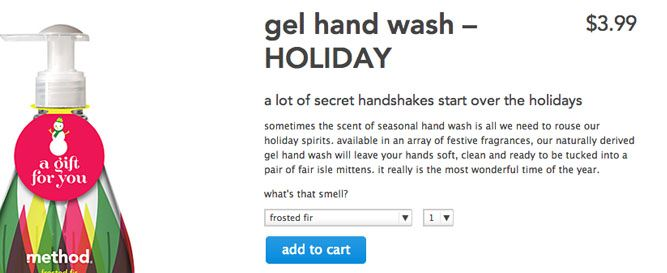
4. Use storytelling
Emotional stories have an unending potential of grabbing our attention as readers. Advertising and copywriting are industries that emphasize and utilize the power of storytelling excellently. We all are aware of the fact that emotions inspire people. Find that emotional link between your brand’s product and the target audience. What is it that connects them to this specific product? And how deeply do they relate to it?
Now, channel this information with the help of creativity into a description that will not fail to engage the customer. Tell stories that convert. The below product description for the Alfa Romeo 1900 C Super Sprint is a brilliant example of brief and precise storytelling that also has the potential to convert:
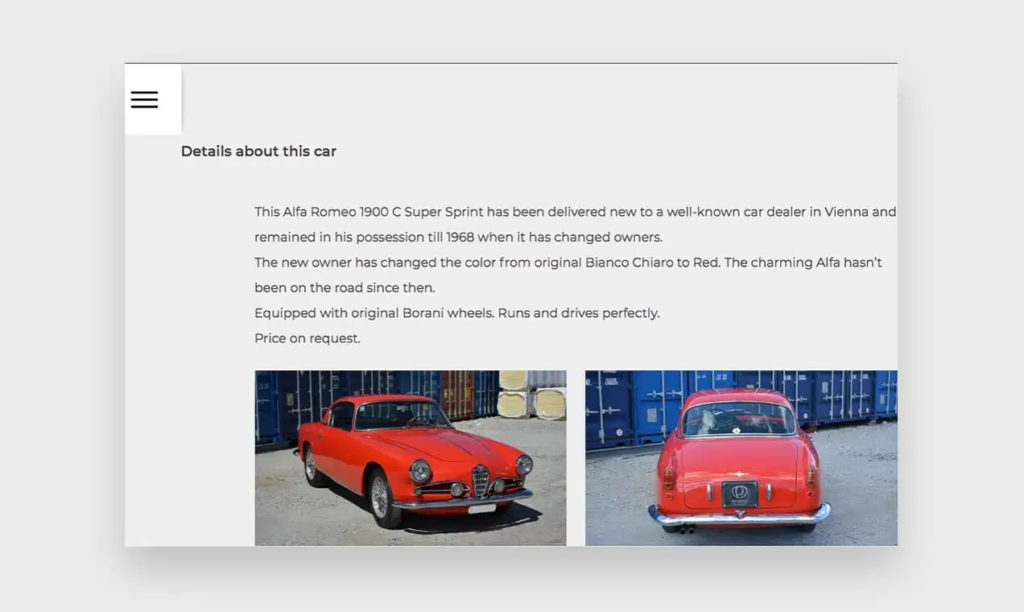
5. Make it more readable
Product descriptions are not lectures; they need to be short and crisp. Write descriptions that are easy to read. Bullet points and numbered lists can be used for listing benefits or features. Highlight the important points so that they draw the clear attention of the reader. Bullets and highlights help the reader cut through the clutter of text and focus on the most important details.
Choose the key features or the most important benefits while highlighting. Highlighting each and every line defeats the purpose. With the decreasing attention span of the digital customer, most of us today tend to skim across the text whenever reading something online.
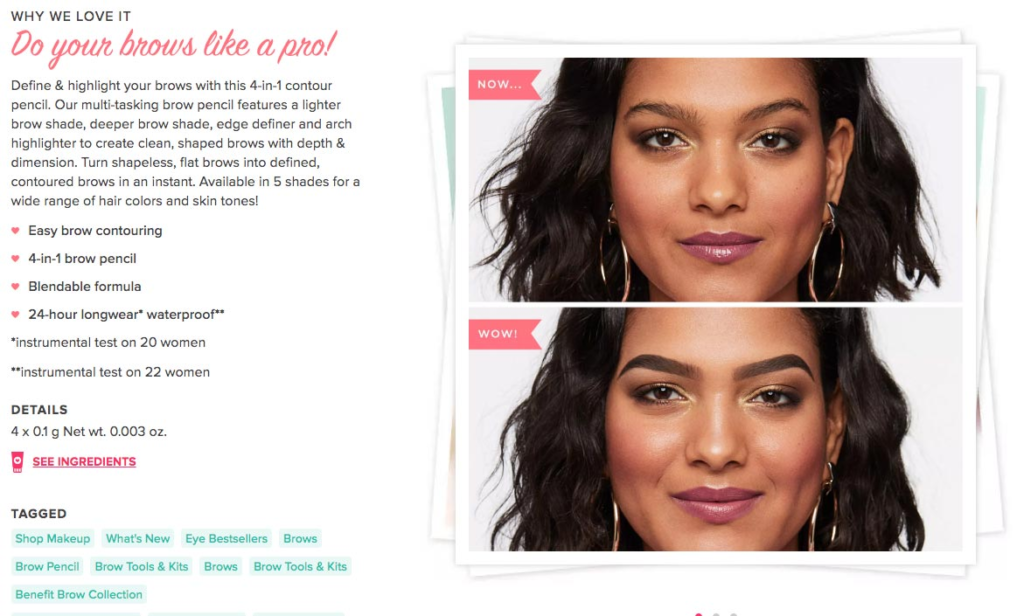
6. Use the power of SEO
A well-written product description naturally drives SEO. But it is still important to keep keywords in mind. Using the right keywords at the right places within the product description can help a brand’s page rank higher in the search results. This will eventually increase the website’s ranking. Thus, it is a good idea to keep adding relevant keywords to the product pages.
Make sure that the keywords fit in seamlessly with the text flow and the message. Unique keywords, header, meta tags, and geo-locations can be added to each product page. Usually, keywords are used in the page’s URL, once in the product’s title, and ideally not more than two to three times in the body of the product description copy. Including keywords in the descriptions can lead to organic traffic, positively impacting conversions. Thorough keyword research is important for this.
7. Add photos and videos
Multimedia elements are always attractive and cut through the monotony of plain text. Digital media is centered around audio and video elements. Product descriptions do not necessarily have to be just text. Add images and product videos explaining how to use a specific product or give a 360-degree view of the product. The customer will engage better with such a product description. Include different angles while clicking product photographs. Images and videos are as crucial as the text in creating a product page that compels viewers to buy a product.
8. Do not persuade unnecessarily
No one likes being sold to. We all personally hate schemes and messages that direct or order us to buy or purchase a product or service upfront. Write product descriptions that do not constantly remind your audience that your brand is selling them something and pressurizing them. Share stories, add anecdotes, ask questions, draw the viewers in and make them a part of the conversation. Make them feel like they are exploring through the products and their features.
The Laithwaites, a wine company in the UK, is an excellent example of writing compelling product descriptions using the art of storytelling. A story-like description lures in the readers, thereby engaging them to find relevance with their product. Fun background information and a few facts about wine production make their descriptions extremely readable.
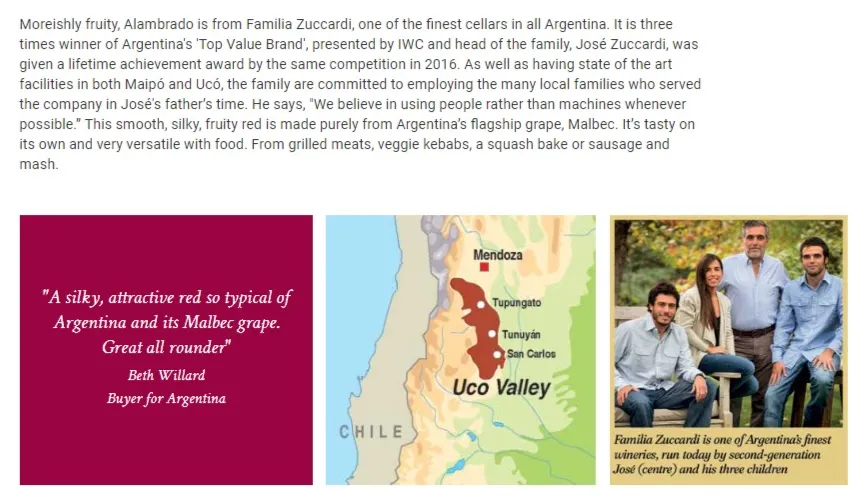
Key Takeaways
- Product descriptions exhibit the value and uniqueness of a product or service and how it solves a potential customer’s problem to the people visiting the company website.
- Well-written product descriptions act as a sales pitch. When customers feel well informed and find the product relevant, they are sure to buy it.
- Product descriptions boost conversions, impact sales, strengthen a brand’s identity, build trust between the customers and also impact a website’s SEO.
- Some important things to include in the product description include nature, purpose, appearance and function of the product or service.
- While writing product descriptions, it is important to keep customer questions as well as product questions in mind. Use adjectives, highlight important words, talk about the USPs of the product, touch upon the features and the benefits.
- A great way to start writing a product description is by creating a buyer persona.
- The prime focus of a well-crafted product description is undoubtedly the benefits and key features of the product.
- Use bulleted lists to increase readability.
- Storytelling is a great way to write product descriptions that are non-pressurizing yet persuasive.
- Usually, keywords are used in the page’s URL, once in the product’s title, and ideally not more than two to three times in the body of the product description copy.
Conclusion
Product descriptions have moved beyond just black text on a plain white background. So the next time you are wondering how to write product descriptions that sell, keep in mind that you can include stories, anecdotes, experiences, questions, insights, and whatever unique element your imagination can spur up while describing a product.
FAQs
The product description should ideally be between 300 to 400 words. Although this word count usually depends on the product and the necessity to address its main features
Best-selling items often have the most detailed and informative product descriptions. Some essential things to include in a product description are the product’s features, its benefits to the buyer, and the unique solution that the product offers to the buyer.
Product descriptions influence sales in a major way. They are essential for a successful online business. The information shared by a company in the form of product descriptions is what persuades the consumer towards making a buying decision.
Yes, it is essential to tailor product descriptions keeping the target audience in mind. Understanding the audience is the most important aspect of crafting a compelling product copy.
While writing product descriptions that include features and benefits of the product, it is not necessary to list out each and every benefit. You can pick the three features with the highest value and describe their advantages.
Latest Blogs
Explore how Google’s 2025 AI search updates triggered ranking chaos. Learn actionable strategies to adapt your SEO for AI Overviews, zero-click searches, and SERP volatility. Stay ahead now.
Learn how to rank on AI search engines like ChatGPT, Perplexity, and Gemini by optimizing your content for authority, structure, and relevance. Stay ahead in AI-driven search with this strategic guide.
Explore the best healthcare SEO services for your medical practice. Improve online visibility and effectively reach more patients in need of your services.
Get your hands on the latest news!
Similar Posts

B2C Marketing
5 mins read
Top Choices for Best Content Marketing Services in B2B Industries

Artificial Intelligence
5 mins read
How A Lead Generation Specialist Can Use AI-Powered Content Funnels to Drive Conversions

Artificial Intelligence
4 mins read